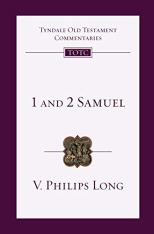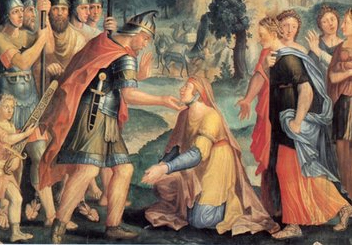Was King Saul a Victim or a Sinner?

The story of King Saul in the books of 1&2 Samuel is certainly tragic. When Saul dies on the battlefield against the Philistines (1 Sam. 31), it is hard not to feel that a life of great potential has been wasted. As a reader of Saul’s story, I do not celebrate his demise but feel a sense of sadness and grief. Interestingly, David is portrayed as having the same feelings in spite of Saul’s tireless pursuit to destroy him (2 Sam. 1). Some modern commentators have an even stronger reaction to Saul’s story, suggesting that the cards were stacked against him from the beginning. Saul becomes a victim of Yahweh, or Samuel, or the pro-Davidic author. Thus, a modern debate has emerged as to whether King Saul was a victim or a sinner? In other words, were the choices that Saul made responsible for his downfall, or was there a more sinister plan at work? Was there a divine plan that spelled doom for Saul from the very beginning no matter he did? Was he merely a pawn in the Divine game plan of kingship?
Saul Was a Victim: Gunn and Brueggemann
Gunn’s View
 Although one can find ancient Rabbis who extolled Saul as one of Israel’s heroes, the modern debate was fueled by two scholars in particular. The first of these, David M. Gunn, published a work entitled: The fate of King Saul: An Interpretation of a Biblical Story in 1989, arguing for the victimization of Saul by Israel’s God. In examining the sin of Saul described in 1 Samuel 13 and 15, Gunn concludes: “. . . there is essentially no failure on Saul’s part to be accounted for, no failure, that is to say, for which he can be held seriously culpable” (p. 56). Furthermore, he states, “From the moment of his anointing the future is loaded against him (in the form of the fatally ambiguous instruction of 10:8) and from his establishment as king in chapter 11 it is as though fate has become his active antagonist, thwarting and twisting his every move” (p. 115). For Gunn, this stacking of the deck against Saul, must ultimately be blamed on Israel’s God, Yahweh. Gunn takes a very low view of God, or at least, as he sees how the story presents God. He writes, “Expressed in terms of a story of character and action, however, Saul falls victim to Yahweh’s resentment at an imagined insult (the “sin”) and becomes the pawn (or scapegoat) in a process (the “expiation”) whereby Yahweh vindicates his shift of attitude towards the monarchy and buttresses his shaken self-esteem” (p. 128). That’s about the nicest thing that Gunn has to say about Yahweh’s portrayal in the books of Samuel. He goes further when he writes, “Yahweh manipulates Saul mercilessly, and he does so for what, on most people’s terms, must count as less than honourable motives. He is insulted, feels jealous, is anxious to justify himself. It is tempting to say that this is the human face of God—but to say that would be perhaps to denigrate humankind, which is not something this Old Testament story does; rather we might say that here we see the dark side of God” (p. 129). Gunn’s Star Wars terminology (theology?) is found again in the final lines of his book where he notes that while the David story does show a “light side” to God, when it comes to Saul, the story shows that “God does have a dark side” (author’s emphasis, p. 131).
Although one can find ancient Rabbis who extolled Saul as one of Israel’s heroes, the modern debate was fueled by two scholars in particular. The first of these, David M. Gunn, published a work entitled: The fate of King Saul: An Interpretation of a Biblical Story in 1989, arguing for the victimization of Saul by Israel’s God. In examining the sin of Saul described in 1 Samuel 13 and 15, Gunn concludes: “. . . there is essentially no failure on Saul’s part to be accounted for, no failure, that is to say, for which he can be held seriously culpable” (p. 56). Furthermore, he states, “From the moment of his anointing the future is loaded against him (in the form of the fatally ambiguous instruction of 10:8) and from his establishment as king in chapter 11 it is as though fate has become his active antagonist, thwarting and twisting his every move” (p. 115). For Gunn, this stacking of the deck against Saul, must ultimately be blamed on Israel’s God, Yahweh. Gunn takes a very low view of God, or at least, as he sees how the story presents God. He writes, “Expressed in terms of a story of character and action, however, Saul falls victim to Yahweh’s resentment at an imagined insult (the “sin”) and becomes the pawn (or scapegoat) in a process (the “expiation”) whereby Yahweh vindicates his shift of attitude towards the monarchy and buttresses his shaken self-esteem” (p. 128). That’s about the nicest thing that Gunn has to say about Yahweh’s portrayal in the books of Samuel. He goes further when he writes, “Yahweh manipulates Saul mercilessly, and he does so for what, on most people’s terms, must count as less than honourable motives. He is insulted, feels jealous, is anxious to justify himself. It is tempting to say that this is the human face of God—but to say that would be perhaps to denigrate humankind, which is not something this Old Testament story does; rather we might say that here we see the dark side of God” (p. 129). Gunn’s Star Wars terminology (theology?) is found again in the final lines of his book where he notes that while the David story does show a “light side” to God, when it comes to Saul, the story shows that “God does have a dark side” (author’s emphasis, p. 131).
Brueggemann’s View
 A year following the appearance of Gunn’s work, Walter Brueggemann produced a commentary in the Interpretation series on First and Second Samuel (Brueggemann, W. (1990). First and Second Samuel. Louisville, KY: John Knox Press). Brueggemann also argued that Saul’s fate was predetermined. Although the responsibility for this ultimately must be laid at God’s feet, Brueggemann spends a lot of time villainizing the prophet Samuel. Regarding Samuel’s rebuke of Saul in 1 Samuel 13 he writes, “On all these grounds it appears that Samuel plays a daring, brutal game with Saul’s faith, Saul’s career, and eventually Saul’s sanity. We do not know if Samuel had the oracle in hand and withheld it from Saul or if there never was in fact such a promise. Is the statement only a fabrication designed to torture Saul? We do not know” (p. 101). Brueggemann suggests that Samuel’s antagonistic nature toward Saul might be partially responsible for Saul’s later instability. Brueggemann also casts blame on both the inspired author and God when he states, “If so, Saul’s argument and justification were irrelevant and he never had a chance—because the narrative has stacked the cards in the favor of David; because Samuel is so partisan; because the literature is deeply committed to David, even before David explicitly appears in the literature; because Yahweh had committed to David before the literature was ever cast” (p. 101). Once again Saul is cast as a victim, which leads Brueggemann to conclude: “The outcome is that Saul is defeated by the combination of Yahweh-Samuel-David before he ever joins the struggle” (pp. 101-102).
A year following the appearance of Gunn’s work, Walter Brueggemann produced a commentary in the Interpretation series on First and Second Samuel (Brueggemann, W. (1990). First and Second Samuel. Louisville, KY: John Knox Press). Brueggemann also argued that Saul’s fate was predetermined. Although the responsibility for this ultimately must be laid at God’s feet, Brueggemann spends a lot of time villainizing the prophet Samuel. Regarding Samuel’s rebuke of Saul in 1 Samuel 13 he writes, “On all these grounds it appears that Samuel plays a daring, brutal game with Saul’s faith, Saul’s career, and eventually Saul’s sanity. We do not know if Samuel had the oracle in hand and withheld it from Saul or if there never was in fact such a promise. Is the statement only a fabrication designed to torture Saul? We do not know” (p. 101). Brueggemann suggests that Samuel’s antagonistic nature toward Saul might be partially responsible for Saul’s later instability. Brueggemann also casts blame on both the inspired author and God when he states, “If so, Saul’s argument and justification were irrelevant and he never had a chance—because the narrative has stacked the cards in the favor of David; because Samuel is so partisan; because the literature is deeply committed to David, even before David explicitly appears in the literature; because Yahweh had committed to David before the literature was ever cast” (p. 101). Once again Saul is cast as a victim, which leads Brueggemann to conclude: “The outcome is that Saul is defeated by the combination of Yahweh-Samuel-David before he ever joins the struggle” (pp. 101-102).
Saul Was Not a Victim, He was a Sinner
 Most evangelical commentators take the more traditional interpretation that Saul was rejected because of his own disobedient choices. Robert Vannoy notes the controversy over whether Saul was victim or sinner and states, “While it is clear that Saul faced great difficulties in assuming the responsibilities of his office, it is not so clear that his behavior is properly understood as that of a pawn moved about on the chessboard of life by a malevolent deity” (Vannoy, J. R. (2009). Cornerstone Biblical Commentarya: 1-2 Samuel (Vol. 4, p. 94). Tyndale House Publishers). In a recent commentary, V. Philips Long summarizes Saul’s problem this way: “The heart of his failure is his neglect of the word of Yahweh. Saul obeys up to a point, but that is the problem. He obeys only up to the point at which other concerns begin to carry more weight” (Long, V. P. (2020). 1 and 2 Samuel: An Introduction and Commentary (D. G. Firth, Ed.; Vol. 8, p. 168). IVP Academic: An Imprint of InterVarsity Press.).
Most evangelical commentators take the more traditional interpretation that Saul was rejected because of his own disobedient choices. Robert Vannoy notes the controversy over whether Saul was victim or sinner and states, “While it is clear that Saul faced great difficulties in assuming the responsibilities of his office, it is not so clear that his behavior is properly understood as that of a pawn moved about on the chessboard of life by a malevolent deity” (Vannoy, J. R. (2009). Cornerstone Biblical Commentarya: 1-2 Samuel (Vol. 4, p. 94). Tyndale House Publishers). In a recent commentary, V. Philips Long summarizes Saul’s problem this way: “The heart of his failure is his neglect of the word of Yahweh. Saul obeys up to a point, but that is the problem. He obeys only up to the point at which other concerns begin to carry more weight” (Long, V. P. (2020). 1 and 2 Samuel: An Introduction and Commentary (D. G. Firth, Ed.; Vol. 8, p. 168). IVP Academic: An Imprint of InterVarsity Press.).
Conclusion: Victim or Sinner?
 The words “victim” and “sinner” are laden with emotion in today’s society. One is a popular term used to derive pity (and at times to manipulate!), while the other is an unpopular, seemingly judgmental term rarely used. Vannoy notes the power of the term “victim” when he writes, “This approach {i.e., Gunn’s and Brueggemann’s] agrees not only with the opinion that Saul had of himself but also with the contemporary tendency to account for many human failures by appealing to victimization” (p. 94). In spite of the popular “victim mentality,” so prevalent in western society, there are a number of good reasons why 1&2 Samuel picture Saul as a sinner, not a victim.
The words “victim” and “sinner” are laden with emotion in today’s society. One is a popular term used to derive pity (and at times to manipulate!), while the other is an unpopular, seemingly judgmental term rarely used. Vannoy notes the power of the term “victim” when he writes, “This approach {i.e., Gunn’s and Brueggemann’s] agrees not only with the opinion that Saul had of himself but also with the contemporary tendency to account for many human failures by appealing to victimization” (p. 94). In spite of the popular “victim mentality,” so prevalent in western society, there are a number of good reasons why 1&2 Samuel picture Saul as a sinner, not a victim.
- One of the primary messages of 1&2 Samuel is first enunciated in 1 Samuel 2:30 when God states, “Those who honor me, I will honor, and those who despise me shall be lightly esteemed.” This statement explains the basis on which God raises up some and brings down others (see my article on the theology of Samuel). V. Philips Long notes this as well (p. 168).
- In the Hebrew canon, the books of Samuel fall among the division known as The Prophets. Specifically, 1&2 Samuel are among the Former Prophets (Joshua-2 Kings). Each of these books highlight the importance of the prophetic word. As such, Saul’s continual violation of God’s word demonstrates a disobedient nature. As king, Saul is God’s representative. Therefore, when Saul continues to misrepresent God through his disobedience, his kingship is terminated. The importance of this truth is emphasized in Samuel’s speech in 1 Samuel 12:14-15, 24-25), which immediately precedes the accounts of Saul’s disobedience.
- The narrative goes to great lengths to demonstrate that God does everything in his power to set Saul on the right path toward godly kingship. A) God gives Saul 3 confirming signs through Samuel that he has been chosen as king (1 Sam. 10:1-7); B) God changes Saul’s heart (1 Sam. 10:9); C) God fills Saul with his Spirit, Saul prophesies, and people who know Saul are amazed at the change in him (1 Sam. 10:10-13); D) God touches the hearts of valiant men to join Saul and support his kingdom (1 Sam. 10:26); E) God gives prophetic guidance to Saul through Samuel; F) God gives Saul multiple opportunities to demonstrate his obedience.
When all of the above factors are taken into consideration, it becomes apparent that 1&2 Samuel are demonstrating that Saul’s rejection is his own fault. In spite of God’s (and Samuel’s) best efforts, Saul willfully disobeys. Thus, Saul is not a victim; he is a sinner.
I do not mean to minimize the circumstances of those who truly are victims today. There are some, through no fault of their own, who are victimized by evil people. We can even find this in Scripture (e.g., the Levite’s concubine in Judges 19). Saul, however, is not a victim. His story stands as an example for those who choose the path of disobedience and experience its consequences. As unpopular as the term today might be, Saul is a sinner and sin and sinner are words we would do well to add back into our modern vocabulary. Today many are considered victims and few are considered sinners. In reality, however, it is most likely the other way around.
























